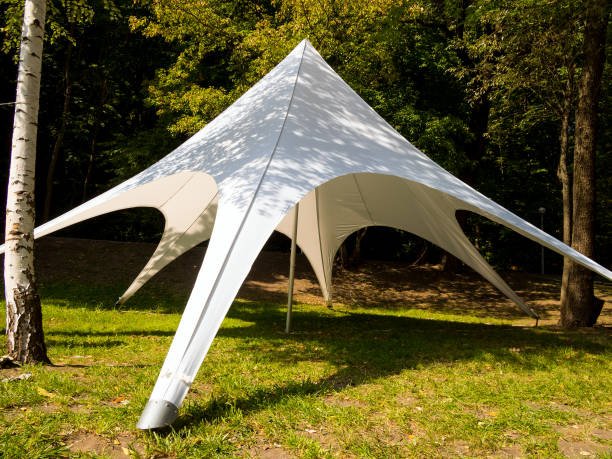A Tarp Tent, also known as a tarp shelter or a tarp camping setup, is a versatile and lightweight outdoor shelter created using a tarp or a waterproof sheet of fabric. It’s a popular choice among hikers, backpackers, and campers who value simplicity, versatility, and minimalist camping. Unlike traditional tents, tarp tents offer a more open and adaptable design, allowing campers to customize their shelter based on weather conditions, terrain, and personal preferences.
Tarp tents are favored for several reasons
Lightweight and Compact:
Tarps are significantly lighter and more compact than conventional tents, making them ideal for backpacking trips or any situation where weight and space are at a premium.
Versatility:
Tarp tents can be set up in various configurations, from a simple lean-to to a more elaborate A-frame or diamond shape, allowing campers to adapt to different terrains and weather conditions.
Ventilation:
The open design of tarp tents provides excellent ventilation, which can be beneficial in warm or humid climates, preventing condensation buildup and ensuring a comfortable sleeping environment.
Cost-effective:
Tarps are generally less expensive than traditional tents, making them an economical option for budget-conscious campers or those just starting in the outdoor adventure.
Customizable:
With a tarp tent, campers have the freedom to create their desired shelter, adjusting the size, shape, and height to suit their needs.

Setting Up a Tarp Tent: Step-by-Step Guide
While setting up a tarp tent may seem daunting at first, it’s a straightforward process that can be mastered with a bit of practice. Here’s a step-by-step guide to help you get started:
Choose your location: Select a flat, level area free of debris and potential hazards like overhanging branches or rocks. If possible, find a spot with natural windbreaks or anchor points like trees or boulders.
Gather your materials: You’ll need a tarp (preferably a lightweight, waterproof tarp made of ripstop nylon or polyester), a ridgeline or paracord, stakes or anchors, and optional accessories like trekking poles, extra cordage, or a groundsheet.
Set up the ridgeline: Tie one end of your ridgeline or paracord to a sturdy anchor point (like a tree or a large rock), and the other end to a second anchor point, creating a taut line at your desired height. This will serve as the backbone of your tarp tent.
Drape the tarp: Unroll your tarp and drape it over the ridgeline, ensuring it’s centered and evenly distributed. Adjust the tarp’s shape and height as needed.
Stake it down: Use stakes or anchors to secure the tarp’s corners and edges to the ground. If you’re on rocky terrain, you can use rocks or logs as anchors instead.
Adjust the tension: Once the tarp is staked down, adjust the tension by pulling on the corners and sides until the desired shape and tautness are achieved. This will help prevent sagging and ensure stability in windy conditions.
Add guy lines (optional): For added stability and to create more interior space, you can attach guy lines from the tarp’s corners or sides to additional anchor points.
Finalize the setup: Tidy up any loose cords or stakes, and make any final adjustments to ensure a secure and comfortable setup.
Remember, there are various tarp tent configurations, such as the A-frame, lean-to, and diamond shapes, each with its setup nuances. Experiment to find the style that best suits your needs and preferences.

How to Make a Tent Out of a Tarp
While purchasing a dedicated tent can be convenient, the ability to craft your shelter from a tarp is a valuable skill for any outdoor enthusiast. Not only does it save money, but it also encourages self-reliance and resourcefulness. In this comprehensive guide, we’ll walk you through the process of transforming a simple tarp into a functional and weatherproof tent.
Materials Needed:
- Tarp (choose a size and material suitable for your intended use)
- Paracord or rope (for ridgelines, guy lines, and lashing)
- Trekking poles or sturdy sticks
- Stakes or anchors
- Groundsheet (optional)
- Duct tape or repair tape
Step 1: Choose Your Tent Design Before you start building, decide on the type of tent you want to create. Some popular options include:
A-Frame Tent: This classic design features two trekking poles or sticks supporting the ridgeline, creating an A-shaped structure. Lean-To-Tent: A simple yet effective design that relies on a single ridgeline tied between two anchor points, with the tarp leaning against it. Diamond Tent: Also known as a pyramid tent, this design uses a single pole or stick in the center, with the tarp draped over it and staked down at the corners.
Step 2: Set Up the Frame Gather your trekking poles or sturdy sticks, and create the frame for your chosen tent design. For an A-frame tent, lash or tie the two poles together at the top, forming an A-shape. For a lean-to or diamond tent, set up a single pole or stick as the central support.
Step 3: Attach the Ridgeline Tie one end of your paracord or rope to the top of your frame (for an A-frame or diamond tent) or between your two anchor points (for a lean-to tent). This will serve as the ridgeline, providing the backbone for your tarp tent.
Step 4: Drape the Tarp Unroll your tarp and drape it over the ridgeline, ensuring it’s centered and evenly distributed. Adjust the tarp’s shape and height as needed.
Step 5: Stake It Down Use stakes or anchors to secure the tarp’s corners and edges to the ground. If you’re on rocky terrain, you can use rocks or logs as anchors instead.
Step 6: Add Guy Lines (Optional) For added stability and to create more interior space, attach guy lines from the tarp’s corners or sides to additional anchor points. This will help prevent sagging and ensure your tent can withstand wind and weather.
Step 7: Finalize the Setup Tidy up any loose cords or stakes, and make any final adjustments to ensure a secure and comfortable setup. If desired, add a groundsheet inside the tent for extra protection and insulation.
Step 8: Weatherproofing (Optional) If you anticipate rain or heavy winds, consider reinforcing your tarp tent with additional guy lines, duct tape, or repair tape to seal any potential leaks or weak points.

Topics You Should Think About
Tarp Material and Size: Choose a tarp made of lightweight, waterproof, and durable materials like ripstop nylon or polyester. Consider the size based on the number of occupants and the desired interior space.
Weather Protection: While tarp tents offer excellent ventilation, they may not provide the same level of weather protection as a traditional tent. Be prepared to reinforce your setup or seek additional shelter in extreme conditions.
Site Selection: Proper site selection is crucial for a successful tarp tent setup. Look for level ground, natural windbreaks, and anchor points like trees or boulders.
Ventilation and Condensation: Tarp tents excel at ventilation, but condensation can still occur in certain conditions. Consider leaving a vent or opening for airflow, and use a groundsheet to protect against moisture.
Privacy and Bug Protection: Tarp tents offer an open design, which may not provide the same level of privacy or bug protection as a traditional tent. Consider adding a bug net or using additional tarps for privacy if needed.
Versatility and Customization: Embrace the versatility of tarp tents by experimenting with different configurations and customizing your setup to suit your needs and the environment.
Practice and Experience: Setting up a tarp tent takes practice and experience. Don’t be discouraged if your initial attempts aren’t perfect. Keep refining your skills, and soon you’ll be an expert at creating comfortable and weatherproof tarp shelters.
Tarp Tent vs. Traditional Tent Comparison
| Feature | Tarp Tent | Traditional Tent |
|---|---|---|
| Weight | Lightweight | Heavier |
| Packability | Compact and easy-to-pack | Bulkier and less compact |
| Ventilation | Excellent ventilation | Limited ventilation |
| Weather Protection | Good, but less protection than traditional tents | Better protection against rain and wind |
| Privacy | Limited privacy | More privacy |
| Bug Protection | Limited bug protection | Better bug protection |
| Versatility | Highly versatile and customizable | Limited customization options |
| Setup Time | Shorter setup time | Longer setup time |
| Cost | Generally less expensive | More expensive |
FAQs About Tarp Tent
Can I use any tarp for a tarp tent?
While you can technically use any tarp to create a shelter, it’s recommended to choose a lightweight, waterproof, and durable tarp made of materials like ripstop nylon or polyester. These tarps are designed for outdoor use and will better withstand the elements.
How do I choose the right tarp size for my tarp tent?
The tarp size you choose will depend on the number of occupants and the desired interior space. As a general rule, choose a tarp that can comfortably accommodate your group and any gear you’ll be storing inside. A good starting point is a tarp that’s at least 8×10 feet for a solo camper and 10×12 feet or larger for two or more people.
Can I set up a tarp tent without trekking poles or sticks?
Yes, you can set up a tarp tent without trekking poles or sticks, but it may require a different configuration. One option is to create a lean-to tent by tying the ridgeline between two anchor points (like trees or boulders) and staking down the tarp accordingly.
How do I prevent condensation in my tarp tent?
Condensation can be a concern in tarp tents due to their open design. To minimize condensation, consider leaving a vent or opening for airflow, using a breathable groundsheet, and avoiding pitching your tent in low-lying areas prone to moisture buildup.
Can I use a tarp tent in rainy or windy conditions?
Tarp tents can be used in rainy or windy conditions, but you may need to take additional precautions to reinforce your setup. This could include adding extra guy lines, sealing potential leak points with duct tape or repair tape, and seeking natural windbreaks or anchoring your tent more securely.
How do I ensure proper ventilation in my tarp tent?
Proper ventilation is crucial for comfort and preventing condensation buildup in a tarp tent. Consider leaving openings or vents, pitching your tent in a breezy location, and positioning the tarp to allow for cross-ventilation. You can also experiment with different tarp configurations to maximize airflow.
Can I use a tarp tent for winter camping?
While tarp tents can be used for winter camping, they may not provide the same level of insulation and protection from the elements as a dedicated winter tent. If you plan to use a tarp tent in cold weather, consider adding insulating layers like a groundsheet and sleeping pad, and be prepared to reinforce your setup against snow and wind.
Are tarp tents suitable for backpacking trips?
Tarp tents are an excellent choice for backpacking trips due to their lightweight and compact nature. They can significantly reduce the weight and bulk of your gear, making them ideal for long-distance hikes or trips where you need to carry your shelter on your back.
My Closing Words
Embracing the versatility and minimalism of tarp tents can elevate your outdoor adventures to a whole new level. Whether you’re a seasoned camper or a newcomer to the world of tarp camping, the ability to craft your shelter from a simple tarp is a valuable skill that fosters self-reliance and resourcefulness.










